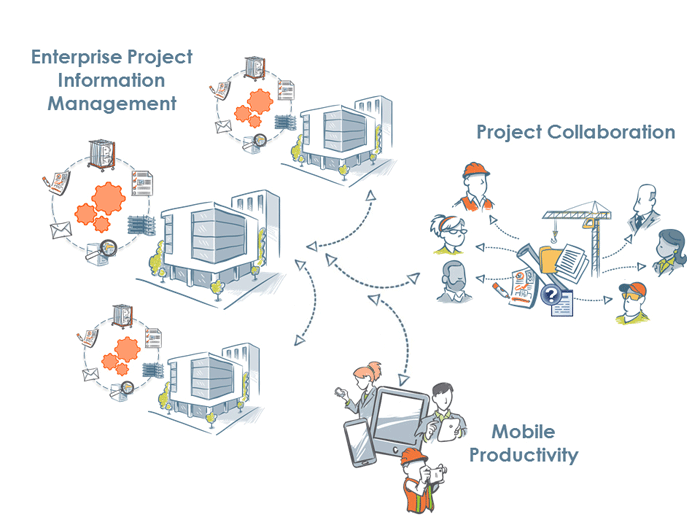The use of Building Information Modelling (BIM) has improved information sharing on construction projects, but, as Newforma’s Tim Bates argues, there are still many areas where information fails to flow at all, let alone seamlessly.
As technology advances it has become evident that our ability to generate more and more electronic data increases at a staggering rate year on year. ‘Big data’ has become a common phrase in our modern vocabulary. The Wikipedia definition of big data is “an all-encompassing term for any collection of data sets so large and complex that it becomes difficult to process using traditional data processing applications”.
The challenges of dealing with an excessive amount of data are very apparent in modern construction projects. What started with the ability to generate large numbers of drawings easily using 2D CAD systems has now accelerated with the introduction of Building Information Modelling (BIM). This, together with the internet, cloud-based technologies, email and the proliferation of smart mobile devices has only served to add to these challenges.
There is a real danger around treating all data as valuable and therefore, by inference, the expectation that the more data we can generate the better. However, note that data is not necessarily the same as information.
One of the early advocates of the adoption of BIM, Jim Bedrick AIA, director of systems integration at Webcor Builders, wrote in 2004 that “the advance from CAD to BIM is the jump from data to information. Information occurs when data is given relevance and meaning”. Information has taken on a new relevance as this technology becomes the norm in our industry.
Mr Bedrick went further and talked about knowledge as “information coupled with experience and know-how” — for example when information is in the hands of an experienced engineer.
The ability for professionals to have access to relevant and appropriate information in a timely manner, and to be able to act on it based on their experience, is key to successful project delivery.

Tim Bates, Newforma’s operations director for EMEA, has responsibility for all sales and service-related activities.
Common data environment
BS1192:2007 is a British standard that has provided the foundation for establishing “the methodology for managing the production, distribution and quality of construction information”.
Based on the real life experiences of collaborative projects such as BAA Heathrow Terminal 5, the authors detail how a Common Data Environment (CDE) approach can be adopted to allow information to be shared between all members of a project team.
It is interesting to note that the Terminal 5 project started out with the concept of a Single Model Environment (SME), but this description was relinquished in favour of the Common Data Environment tag since it more appropriately described the dispersed and federated nature of the information being managed.
Just as there has been a danger that efficient marketing by vendors has led to a belief in some quarters that purchasing a software product will provide your organisation with the ability to ‘do BIM’, I have been concerned at some recent comments that imply that a Common Data Environment can similarly be purchased as an ‘out of the box’ solution.
The Common Data Environment of BS1192 is unlikely to be achieved by a single software solution; it is a collaborative approach and covers four main areas from work in progress (WIP), through Shared and Published to Archive.
It aims to define processes by which information should flow, accuracy and relevance should be checked, and ownership and responsibility should be attributed.
Although the software component is an important part of delivering this strategy, it will only be successful if all stakeholders agree on a common way of working and sharing information and knowledge.
Information silos
Unfortunately it seems to be an inevitable result of the way that design and construction projects happen that we end up with disconnected silos of information that increase the risk of errors and omissions in the final project delivery.
Those of us who have been in the industry for any length of time will undoubtedly have our own favourite anecdotes of where poor information management has resulted in significant risk and additional cost to a project in both time and money.
Whilst the advent of BIM should have improved the situation, I believe that it has sometimes exacerbated things since there is a temptation to put as much information as possible locked into the BIM model. This not only challenges the requirements of the hardware that is running the modelling solution but it creates its own silo of information that is, in effect, under the restricted ownership and management of those who are trained and experienced in driving such solutions.
In the early days of BIM, if not even earlier, I can remember that many of us had a slide that showed a series of brick walls where information was chucked over to the next stakeholder in the project. BIM was highlighted as part of the solution, and things have definitely improved, but I believe that we still have a long way to go in this respect. Even in the best managed projects there are still areas where information fails to flow at all, let alone seamlessly.
Sometimes this is made worse by incompatible data formats between solutions. Something which the IAI, COBie, BuildingSmart and Open BIM initiatives have gone some way to address, but the commercial realities of many of the software vendors and the quest for even greater intelligence built into their solutions, and therefore the complexities of their data formats, continue to challenge these initiatives.
In practice there are still walls, or disconnects, between different disciplines working in parallel on projects that are simply down to a lack of a collaborative mindset between the stakeholders rather than any fundamental data incompatibility.
Even more fundamental disconnects are still occurring between stages in a project lifecycle. I have also had recent feedback relating to some very high profile projects where the design information passed across to the construction stage is so untrustworthy that a new virtual design and construction (VDC) model has to be developed, almost from scratch. (I much prefer the acronym VDC to that of BIM since I believe it is better at describing the process that we should be aiming for with modern software.)
Back to the future
So where should we go from here? The disconnected nature of the information described earlier could be addressed by two basic approaches.
One solution would be to put an increasing amount of the information relating to a project in a single database or repository that all users can have access to. This route is the one that has led to the project extranet solutions that have often been adopted by contractors, particularly in the UK.
However, one of the biggest complaints I hear from our consultant customers is that this strategy results in a significant disconnect from the management of their on-premise project information, as well as providing an additional workload to their document control processes.
Whilst this approach can be seen to work well as a record of the published information on a project, I believe that it often falls short when trying to address the WIP and shared information areas. This is particularly true when it comes to the often unstructured work in progress information during the early design stages, including emails and their attachments.
This can be where critical information falls through the cracks and the reasons behind a particular design decision is lost; the project record only ends up with the ‘what’.
Add to this the challenges of a global context where projects are often worked on across different offices and geographies, internet access is not always reliable and cloud storage has technical and political implications.
I believe that we have to continue to address the current inevitability that project information is held in disconnected silos, work towards solutions that acknowledge this and develop more intelligent and connected federated systems for collaborating across all of the information on a project.
If you enjoyed this article, subscribe to AEC Magazine for FREE






